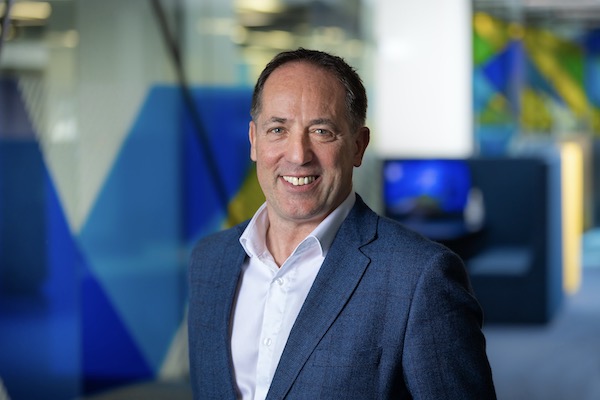Published on the 30/09/2025 | Written by Heather Wright

Stephen Hastings on AI, data and the future of insurance…
Tower Insurance is looking to agentic AI as the next step to automate claims processes, using data and the technology to accelerate claims processing for customers while removing some of the mundane tasks for employees.
Dr Stephen Hastings, who recently took over as chief data and analytics officer for the insurance company, says agentic lends itself well to handling some of the claims processes, but acknowledges it’s still early days and both generative AI and agentic are emerging, and relatively nascent, technologies.
“In insurance there is a lot of data, which makes life very interesting for someone in my role.”
“Where organisations are successful in this is where they are really focusing on the business value and the key business problems they want to solve and then applying AI to that. It’s really important to have that business focus, rather than just a pure technology focus,” Hastings, who also leads Tower’s AI capabilities, told iStart.
Tower has experimented with proof of concept and proof of value around the claims agents, and Hastings says the company has ambitions to accelerate that work in the upcoming new financial year.
“It’s relatively early days where I have developed our AI enablement strategy and we are changing the operating model a little bit to accommodate AI and hiring roles in that space – thinking about the types of new roles we need and how we are going to tackle the various use cases for each of our business units.”
Cross functional teams, blending technology and architecture teams with business domain experts, are being harnessed to identify and tackle specific use cases and ensure ‘the best outcomes’
Hastings, who moved into the Tower role in August after five months as head of data for the company, previously founded and led KPMG New Zealand’s Digital Lighthouse division, and says he’ll be bringing many of the lessons learned in his consulting role through to Tower – including growing a strong data and AI team.
“I started the Digital Lighthouse team from scratch and we built it to over 60 individuals so it was a really good exercise in building the team and the grad program and organising into chapters.”
He’s keen to ‘reinvigorate’ Tower’s graduate and intern programs, saying nurturing talent from university and growing and developing teams is a model he’s found successful in the past.
“It’s a new technology and everyone is learning so we might as well get the smart cookies out of university and shape them as well.”
But the company will also be going after ‘the best talent’ as well, he says.
Transforming insurance
Hastings says there is ‘huge’ opportunity to accelerate transformation through smart, safe use of data, analytics and AI.
“In insurance in general there is a lot of data, which makes life very interesting for someone in my role.
“Tower, being a New Zealand owned organisation and being relatively nimble has an opportunity to really move forward with our data and digital strategy and get the most of the digital assets we have.”
Hastings says data and AI will be instrumental in helping insurance companies become more operationally efficient and serve customers better and more efficiently in the coming years.
Deeper understanding of customers and segments of customers will enable the company to further tailor online experiences, showcasing specific products and services based on a customer’s life stage or needs.
“Similarly, in assisted channels such as call centres, we can use AI to help summarise calls, provide the next best action, the next best conversation so we can reduce call times and wait times and give customers the best service,” he says.
Tower is also using publicly available data sources, including Statistics New Zealand data, council maps and inflation data for its underwriting, with third-party data and historic claims data used for pricing and modelling.
Last year the company integrated the Hello Claims assessing and repair management platform into its online systems to improve motor claims processes for both customers and repairers, and enable customers to view their claims status, receiving real-time updates, throughout the claim journey via the online customer platform.
At the time the company said it aimed to halve total claims turnaround times, reducing the time it takes to allocate a claim to a repairer, authorise repairs and process invoices from three to five days down to a single day.
The Hello Claims software can batch supplier quotes at agreed bulk rates, assessing quotes and can be integrated with leading panel management systems used by many motor repairers. Invoicing times were also sped up under the new system.
Hastings says AI, across its many facets, is definitely the hot topic and ‘quite all encompassing’ currently. Going forward, he says the discussion will be more around interconnectivity of the technology to ensure customers have a seamless experience.
“That’s what we are focused on – those simplified and beautiful customer experiences.”
Lighthouse lessons
Looking back on his time with Digital Lighthouse, Hastings says a key issue he often saw with clients was that focus on technology, rather than solving a business issue.
“We would spend a lot of time upfront around the strategy and either the business risks or opportunities for innovation and really try to prioritise what we go after and then measure that value, because a lot of organisations were also not particularly good at measuring the KPIs and OKRs around analytical initiatives.”
Linking initiatives back to strategy is also a key issue.
“You’d be surprised, a lot of organisations set their strategy and then forget about it until the next year, but having that linkage between the strategy, cascading it down, running initiatives to measure and have it line up against the business strategy – that discipline is really important.”



























